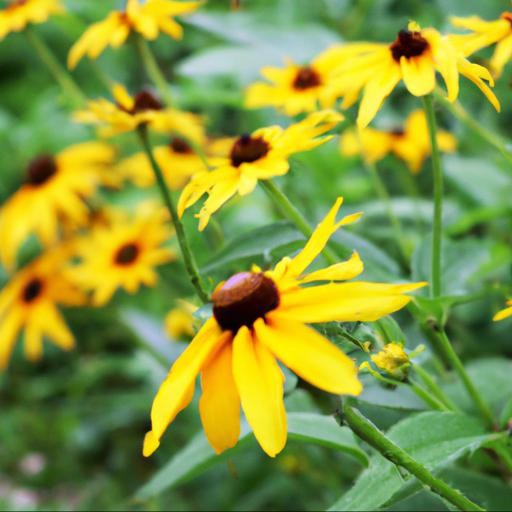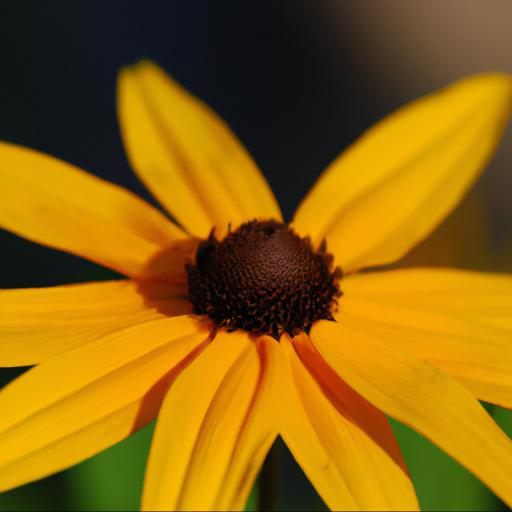Rudbeckia fulgida var. deamii, commonly known as Deam’s Coneflower, is a species of flowering plant native to the United States. It is a perennial herbaceous plant of the Asteraceae family, and is known for its showy yellow flowers.
The plant is highly adaptable, and can be found in a variety of habitats, from prairies to woodlands. Deam’s Coneflower is a great addition to any garden, as it is easy to grow and requires little maintenance.
Its bright yellow flowers are a beautiful addition to any landscape, and its long-lasting blooms make it a favorite among gardeners. The plant also provides a great food source for pollinators, such as bees and butterflies.
Characteristics of rudbeckia fulgida var. deamii

When it comes to adding a beautiful flower to your landscape, few look as remarkable as Rudbeckia fulgida var. deamii.
This daisy-like flowering plant is a unique and striking addition to any garden. Not only is Rudbeckia fulgida var. deamii a striking flower, but it is also quite hardy.
It is a member of the Aster family, and it is native to the United States. The flower is identifiable from its phoenix-shaped, yellow-tone petals which separate from a central brown-colored cone. What makes Rudbeckia fulgida var.
deamii especially interesting is its wide range of environmental requirements. Specifically, these flowers are capable of resisting drought and drought-like conditions, temperatures that can get below freezing, and periods of flooding or extended wetness.
Because of this wide range of capabilities, Rudbeckia fulgida var. deamii can be easily be added to gardens in almost any setting. In addition to its hardiness, Rudbeckia fulgida var.
deamii is also very easy to care for and manage. These plants, which grow in clumps, do not require the laborious pruning that many other flowering plants do.
They will also re-seed theirselves in the fall, ensuring their presence in the garden for years to come. When it comes to flowers that are easy to plant, require minimal maintenance, and will survive in any kind of weather, few compare to the Rudbeckia fulgida var. deamii.
Growing and caring for rudbeckia fulgida var. deamii

Much of the appeal of Rudbeckia fulgida var. deamii lies in its easy-care nature combined with its vibrant, daisy-like blooms. As a part of the daisy family, it is an attractive option for any garden.
It is native to the midwestern and southeastern United States, where it thrives under partial sunlight and produces spectacular flowers from late spring through to early autumn. A task of growing and caring for these Rudbeckia may seem intimidating for a first-time gardener, but it does not need to be.
The rules are quite simple: provide frequent watering, mulch to keep the plants protected, and ensure the soil is well-draining and amended with organic matter. With a few basic steps, these plants will bloom heavily, making a beautiful and eye-catching display in any garden.
In terms of maintenance, Rudbeckia fulgida var. deamii is as easy to care for as it is beautiful. To encourage heavy flowering, deadhead spent blooms and prune the stems back to encourage bushier growth.
A soil pH between 6-5 is ideal to promote strong, healthy root growth and blooming, and regular fertilization (about once every three weeks) will keep the blooms lasting all summer long. Rudbeckia fulgida var.
deamii is also highly resistant to pests, making it an ideal choice for those looking for a low-maintenance option to brighten up their gardens. All said and done, grooming and caring for Rudbeckia fulgida var.
deamii is a relatively simple affair. For any gardener, novice to expert, these stunning daisy-like blooms can make a beautiful addition to any garden—all you need to do is provide the right care and maintenance.
Uses of rudbeckia fulgida var. deamii

Rudbeckia fulgida var. deamii, or Deam’s Coneflower, is a striking variety of the popular Rudbeckia family.
It is known for its vibrant colors and upright habit that can bring color and texture to a garden all season. Deam’s Coneflower is native to the prairies of the United States, and can typically be found in dry, sandy soil with full sun. Growing up to 4 feet tall, these plants are great for adding height and texture to a garden.
The flowers are orange and yellow, with slightly drooping petals that give the appearance of a sunburst. The height and color of Deam’s Coneflower can help to create a bright and cheerful garden, and make a great backdrop for other perennials. In addition to its visual appeal, Deam’s Coneflower is also a great choice for gardeners who want to attract pollinators.
The daisy-like blooms provide a source of nectar for birds, bees, and butterflies. This makes them the perfect addition to a pollinator gardening scheme.
They are also deer and rabbit resistant, a plus for gardeners in areas where these species are common. Rudbeckia fulgida var.
deamii is best grown from seed or can be planted from a container. The seeds can be started indoors for an early bloom, or planted directly into the garden as soon as the soil can be worked in the spring. When planting, be sure to space them at least three feet apart to give them plenty of room to grow.
With regular watering and full sun, they can be enjoyed all season long.
Interesting facts about rudbeckia fulgida var. deamii
Rudbeckia fulgida var. deamii, is an amazing species of wildflower that has many interesting facts and features.
Commonly known as the Brown-Eyed Susan, these plants are native to prairie grasslands in both northeastern and central United States. They feature bright yellow ray petals and a dark brown center. The plants can bloom anywhere from June to October and their flowers usually measure up to three inches in diameter.
Not only are the blossoms of Rudbeckia fulgida var. deamii vibrant and beautiful, but they are also quite hardy. They are capable of thriving in a number of soil types, from sand to clay, and are more drought-tolerant than many varieties.
They also require little to no maintenance, meaning they make fantastic additions to wildflower gardens. The species is also known for its medicinal properties, as it has been used to treat a variety of conditions, including sore throat, coughs, congestion, and even diabetes.
The leaves and roots of the plant can be dried and then brewed as an herbal tea or decoction. Many herbalists and practitioners of traditional medicine also recommend using Rudbeckia fulgida var.
deamii as a tonic for the kidneys, liver, and spleen. Whether planted in rock gardens or wildflower beds, this species of Rudbeckia is sure to bring color and life to any garden. With its long-lasting beauty and medicinally beneficial properties, it really is the perfect addition for a gardener looking for a bit of wildness in their outdoor space.
Conclusion
Rudbeckia fulgida var. deamii is a species of wildflower native to North America. This species is a perennial plant with bright yellow daisy-like flowers and a deep taproot.
It is a popular addition to gardens and landscapes due to its hardiness and vibrant flowers. The plant prefers well-drained soils and full sun, and is drought tolerant.
It is also a great choice for pollinators, providing nectar and pollen to bees, butterflies, and other beneficial insects.
FAQ
What is the scientific name of Rudbeckia fulgida var. deamii?
The scientific name of Rudbeckia fulgida var. deamii is Rudbeckia deamii.
Where is Rudbeckia fulgida var. deamii native to?
Rudbeckia fulgida var. deamii is native to the eastern United States, from New York to Florida and west to Missouri and Texas.
What are the characteristics of Rudbeckia fulgida var. deamii?
Rudbeckia fulgida var. deamii is a perennial wildflower that is native to the eastern United States. It has yellow-orange daisy-like flowers with dark brown centers, and grows to a height of 2-3 feet. The leaves are lance-shaped and have a rough texture. It prefers moist, well-drained soil and full sun to partial shade. It is a drought-tolerant plant and is resistant to deer and rabbits.
How does Rudbeckia fulgida var. deamii differ from other varieties of Rudbeckia fulgida?
Rudbeckia fulgida var. deamii differs from other varieties of Rudbeckia fulgida in that it has a shorter stature, more deeply-lobed leaves, and larger, more showy yellow-orange flowers.
What is the best way to propagate Rudbeckia fulgida var. deamii?
The best way to propagate Rudbeckia fulgida var. deamii is by division in the spring or early summer.
What are the common uses of Rudbeckia fulgida var. deamii?
The common uses of Rudbeckia fulgida var. deamii include ornamental planting, naturalizing, and as a cut flower. It is also used in butterfly and pollinator gardens.

